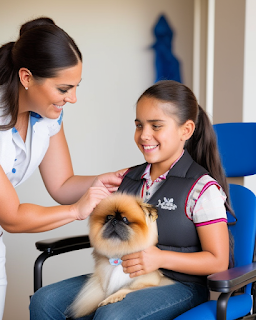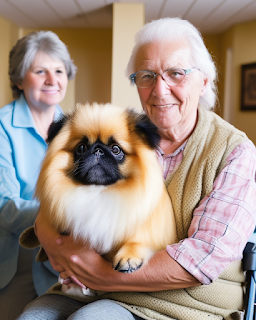"Pekingese as Therapy Dogs: How to Get Your Furry Companion Registered"
Hey there, animal lovers! Are you looking to get your
Pekingese registered as a therapy dog? Well, you've come to the right place! In
this blog post, we'll discuss the steps you need to take to get your furry
friend registered as a therapy dog.
A therapy dog is a specially trained animal that
provides comfort and support to people in need, such as those in hospitals,
retirement homes, or schools. Therapy dogs are not service dogs, which are
trained to perform specific tasks for individuals with disabilities. Instead, therapy
dogs offer emotional support and bring joy to those they visit.
Steps you need to take to get your Pekingese registered as a therapy dog:
Step 1: Assess Your Pekingese's Temperament
The first step in getting your Pekingese registered as
a therapy dog is to assess their temperament. Therapy dogs need to be friendly,
calm, and well-behaved around people. If your Pekingese has a history of
aggression or anxiety, they may not be suitable for therapy work. But don't
worry! If your Pekingese is not a good fit, there are plenty of other ways they
can bring joy to people's lives, such as being a beloved pet or participating
in dog sports.
Step 2: Train Your Pekingese
Assuming your Pekingese has the right temperament for
therapy work, the next step is to train them. Your Pekingese will need to be
well-trained in basic obedience commands, such as "sit,"
"stay," and "come." They will also need to be trained to
walk calmly on a leash and to be comfortable around different types of people,
including children and elderly individuals.
Step 3: Find a Therapy Dog Program
Once your Pekingese is trained and ready to go, the
next step is to find a therapy dog program. There are many organizations that
certify therapy dogs, such as Therapy Dogs International and the American
Kennel Club's Canine Good Citizen program. These organizations have specific
requirements that your Pekingese must meet, such as passing a behavior test and
undergoing a health check-up. They will also provide you with resources and
support to get your Pekingese started on their therapy work.
Step 4: Start Volunteering
Congratulations! Your Pekingese is now a certified
therapy dog. The final step is to start volunteering. You can volunteer at a
variety of places, such as hospitals, nursing homes, schools, and libraries.
It's important to remember that as a therapy dog team, you are there to provide
comfort and support, not to perform any specific tasks. You will need to follow
the rules and regulations of the facility you are visiting and always put your
Pekingese's safety first.
In addition to basic obedience training, your
Pekingese will also need to undergo specialized therapy dog training. This
training will help your Pekingese learn how to interact with different types of
people and how to respond to different situations they may encounter during
therapy visits.
Allow your Pekingese to approach people on their own
terms. Some people may be shy or afraid of dogs, so it's important to respect
their boundaries and never force your Pekingese to interact with them.
It's also important to maintain good hygiene when
volunteering with your Pekingese. Make sure that your Pekingese is clean and
well-groomed before each visit. It's also a good idea to bring along some wipes
or hand sanitizer to clean your hands after each visit.
Remember to have fun and enjoy the experience of
volunteering with your Pekingese. Therapy visits can be a rewarding experience
for both you and your Pekingese, and you'll be making a positive impact on the
lives of others.
Tips for Success
Getting your Pekingese registered as a therapy dog can
be a challenging process, but it's also a rewarding experience that can bring
joy to many people. Here are some tips for success:
Start early - It's never too early to start training
your Pekingese for therapy work. The earlier you start, the more time you have
to develop your Pekingese's skills and temperament.
Be patient - Training a therapy dog takes time and
patience. Don't expect your Pekingese to become a certified therapy dog
overnight.
Stay positive - Positive reinforcement is key to
training a therapy dog. Make sure to reward your Pekingese for good behavior and
keep training sessions fun and engaging.
Practice, practice, practice - Consistency is key to
training a therapy dog. Make sure to practice basic obedience commands and
therapy dog skills regularly.
Have realistic expectations - Not all dogs are suited
for therapy work. If your Pekingese is not a good fit for therapy work, that's
okay! They can still bring joy to people's lives in other ways.
Conclusion
Getting your Pekingese registered as a therapy dog is
a rewarding experience that can bring joy and comfort to many people in need.
By assessing your Pekingese's temperament, training them properly, finding a
reputable therapy dog program, and volunteering, you can make a positive impact
on the lives of others. Remember to stay patient, positive, and have fun along
the way!
References and Suggested Reading: (Click the link to view online):
- American Kennel Club Pekingese Breed Standard: https://www.akc.org/dog-breeds/pekingese/
- Pekingese Club of America: https://pekingeseclubofamerica.com/pekingese-breed-standard/
- Orthopedic Foundation for Animals: https://www.ofa.org/
- Traveling with your dog or cat. American Veterinary Medical Association. (n.d.). Retrieved March 16, 2023, from https://www.avma.org/resources-tools/pet-owners/petcare/cvi/traveling-your-dog-or-cat
- 10 tips for the first 30 days after adopting a dog. PetMD. (n.d.). Retrieved March 16, 2023, from https://www.petmd.com/dog/care/10-tips-first-30-days-after-adopting-dog
- The ultimate guide to traveling with dogs. The Social Movement. (2018, August 31). Retrieved March 16, 2023, from https://blog.konversai.com/ultimate-guide-traveling-dogs/
- WebMD. (n.d.). Traveling with dogs: Tips for safety and security. WebMD. Retrieved March 16, 2023, from https://pets.webmd.com/dogs/guide/how-to-travel-with-your-dog American Kennel Club. "Pekingese Dog Breed Information." https://www.akc.org/dog-breeds/pekingese/
- PetMD. "Pekingese Dog Breed Profile." https://www.petmd.com/dog/breeds/c_dg_pekingese
- Friends, M. F. (n.d.). Grooming a Pekingese. Retrieved March 27, 2023, from https://petgroomingthegoodthebadthefurry.blogspot.com/2011/05/grooming-pekingese.html
- YouTube. (2020, April 24). How to groom a Pekingese (basic trim) - do-it-yourself dog grooming. YouTube. Retrieved March 27, 2023, from https://www.youtube.com/watch?v=5JAFDKehD3U
- Dog training: How to train a dog & dog obedience training. American Kennel Club. (n.d.). Retrieved April 1, 2023, from https://www.akc.org/training
- Cunliffe, J. (2012). Pekingese: A comprehensive guide to owning and caring for your dog. Lumina Media. Pekingese: A Comprehensive Guide to Owning and Caring For Your Dog
- Pisano, B., & Krieger, G. A. (1990). Pekingese. T.F.H. Publications. Pekingese by Beverly Pisano
- Sife, W. (2014). The loss of a pet: A Guide to Coping with the Grieving Process When a Pet Dies. Howell Book House. The Loss of a Pet: A Guide to Coping with the Grieving Process When a Pet Dies
- Dunbar, I. (2004). Before & after getting your puppy: The positive approach to raising a happy, healthy, and well-behaved dog. New World Library. Before & after getting your puppy
- Borzendowski, J. (2007). Caring for your aging dog: A quality-of-life guide for your dog's senior years. Sterling Pub. Caring for your aging dog: A quality-of-life guide for your dog's senior years.
- Bendersky, J. (2014). Diy Dog Grooming, from puppy cuts to best in Show: Everything you need to know, step by step. Quarry. Diy Dog Grooming, from puppy cuts to best in Show: Everything your need to know, step by step
- Coile, D. C., & Earle-Bridges, M. (2006). Pekingese: Everything about purchase, care, nutrition, behavior, and training. Barron's. Pekingese: Everything about purchase, care, nutrition, behavior, and training. Barron's
- Yin, S. A., & Deamer, M. (2010). How to behave so your dog behaves. T.F.H. Publications. How to behave so your dog behaves
- McConnell, P. B. (2003). The other end of the leash: Why we do what we do around dogs. Ballantine Books. The other end of the leash why we do what we do around dogs
- Pryor, K. (2019). Don't shoot the dog: The art of teaching and training. Simon & Schuster Paperbacks. Don't Shoot the Dog: he Art of Teaching and Traini
- Fox Sports. (2021). Westminister Kennel Club Show 2021. YouTube. Retrieved April 16, 2023, from https://youtu.be/GZSIFekthRM.













Comments
Post a Comment